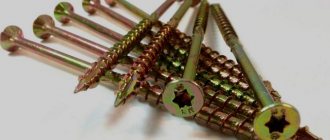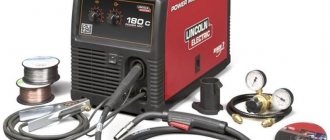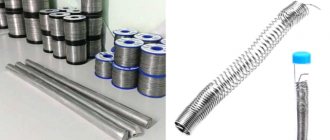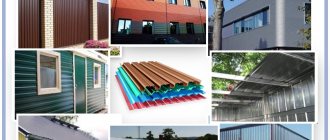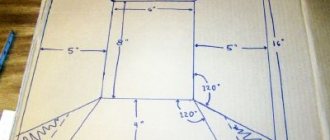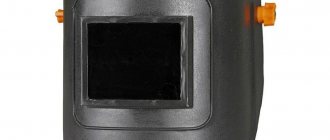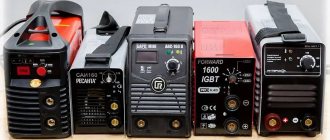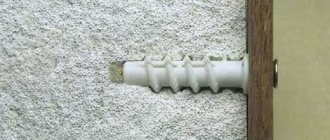In this article we will talk about the types and characteristics of self-tapping screws and help you decide on the choice of fasteners, taking into account the type of material being fastened. What is the difference between self-tapping screws, types of threads and slots?
Currently, there are a large number of fasteners on sale - anchors, dowels, etc., but the use of self-tapping screws
still relevant. The main advantage of self-tapping screws is that there is no need to pre-drill the surfaces to be fastened; using a screwdriver or screwdriver, the self-tapping screw will drill its own path. This results in a reliable fastening.
STEEL SCREWS FOR INSTALLATION OF METAL STRUCTURES SMK/SMM
Phosphated/galvanized steel self-tapping screws with a cone-shaped head for mounting metal profiles.
| Designation | Quantity per pack pcs | ~Weight kg/1000 pcs |
| SMK 3.5×9.5 drill | 1000 | 1.20 |
| SMK 3.5×11 drill | 1000 | 1.26 |
| SMK 3.5×9.5 sharp | 1000 | 1.11 |
| SMK 3.5×11 sharp | 1000 | 1.15 |
Galvanized steel (white zinc) self-tapping screws with a press washer for fastening sheet metal.
| Designation | Quantity per pack pcs | ~ Weight kg/1000 pcs |
| SMM 4.2×13 drill | 1000 | 1.80 |
| SMM 4.2×16 drill | 1000 | 2.00 |
| SMM 4.2×19 drill | 1000 | 2.06 |
| SMM 4.2×25 drill | 1000 | 2.63 |
| SMM 4.2×32 drill | 1000 | 3.08 |
| SMM 4.2×38 drill | 500 | 3.28 |
| SMM 4. 2×41 drill | 500 | 3.42 |
| SMM 4.2×50 drill | 500 | 4.27 |
| SMM 4.2×57 drill | 500 | 4.72 |
| SMM 4.2×75 drill | 500 | 5.60 |
| SMM 4. 2×13 sharp. | 1000 | 1.72 |
| SMM 4. 2×16 sharp. | 1000 | 1.84 |
| SMM 4. 2×19 sharp. | 1000 | 2.06 |
| SMM 4.2×25 sharp. | 1000 | 2.55 |
| SMM 4. 2×32 sharp. | 1000 | 2.92 |
| SMM 4. 2×38 sharp. | 500 | 3.28 |
| SMM 4. 2×41 sharps | 500 | 3.42 |
| SMM 4. 2×50 sharp. | 500 | 4.27 |
| SMM 4.2×57 sharp. | 500 | 4.72 |
| SMM 4.2×75 sharp. | 500 | 5.51 |
What are they?
There are many varieties and classifications of fasteners. According to GOST, universal self-tapping screws differ in different parameters.
- The nature and height of the carving. The latter can be single-start or double-start, its height can be the same or with turns.
- Thread pitch size. It can be large, small or special.
- Head shape. There are square, hexagonal, semicircular, semi-countersunk and countersunk. The most popular fasteners are those with a countersunk head. This product guarantees the creation of a strong assembly between the parts and a flat surface after screwing in, since the head is completely hidden in a special opening.
- Slot shape.
According to this criterion, several types of connecting products are distinguished.
- Galvanized or SHUTS (interpretation: “universal zinc screw”). Zinc is used for coating, which improves corrosion resistance. Self-tapping screws are characterized by strength, reliability and long service life.
- Chrome plated. This type of fastener is most often used to connect parts that will be used in harsh weather conditions.
- Made of stainless steel. These are expensive self-tapping screws, since their physical and technical parameters are quite high.
- From ferrous metals. Self-tapping screws made of ferrous metal are used extremely rarely. It is not characterized by high corrosion resistance and strength.
- From non-ferrous metals. These are brass self-tapping screws, which are most often used in the process of assembling furniture.
PHOSPHATED SCREWS FOR FASTENING GYPSUM CARDBOARD SHEETS
Phosphated steel self-tapping screws with double-thread for mounting plasterboard sheets on metal bases. SGM
| Designation | Quantity per pack pcs | ~ Weight kg/1000 pcs |
| SGM 3.5×16 | 1000 | 1.05 |
| SGM 3.5×19 | 1000 | 1.15 |
| SGM 3.5×25 | 1000 | 1.35 |
| SGM 3.5×32 | 1000 | 1.63 |
| SGM 3.5×35 | 1000 | 1.76 |
| SGM 3.5×41 | 1000 | 2.03 |
| SGM 3.5×45 | 1000 | 2.19 |
| SGM 3.5×51 | 1000 | 2.44 |
| SGM 3.5×55 | 500 | 2.70 |
| SGM 4.2×65 | 500 | 3.58 |
| SGM 4.2×75 | 250 | 4.93 |
| SGM 4.2×90 | 250 | 8.40 |
| SGM 4.8×100 | 250 | 9.17 |
| SGM 4.8×110 | 200 | 9.02 |
| SGM 4.8×120 | 200 | 9.11 |
| SGM 4.8×127 | 200 | 9.17 |
| SGM 4.8×130 | 200 | 9.25 |
Phosphated steel screws for mounting plasterboard sheets on wooden bases. SRS
| Designation | Quantity per pack pcs | ~Weight kg/1000 pcs |
| SRS 3.5×16 | 1000 | 1.05 |
| SRS 3.5×19 | 1000 | 1.15 |
| SRS 3.5×25 | 1000 | 1.35 |
| SRS 3.5×32 | 1000 | 1.63 |
| SRS 3.5×35 | 1000 | 1.76 |
| SRS 3.5×41 | 1000 | 2.03 |
| SRS 3.5×45 | 1000 | 2.19 |
| SRS 3.5×51 | 1000 | 2.44 |
| SRS 3.5×55 | 500 | 2.70 |
| SRS 4.2×65 | 500 | 3.58 |
| SRS 4.2×70 | 250 | 4.45 |
| SRS 4.2×75 | 250 | 4.93 |
| SRS 4.8×90 | 250 | 8.40 |
| SRS 4.8×100 | 250 | 9.17 |
| SRS 4.8×1 10 | 250 | 9.82 |
| SRS 4.8×120 | 250 | 10.48 |
| SRS 4.8×127 | 250 | 1 1.46 |
| SRS 4.8×130 | 100 | 11.46 |
| SRS 4.8×150 | 100 | 13.50 |
Differences in self-tapping screws by design and material of manufacture
The full name of the self-tapping screw is self-tapping screw. It differs from a regular screw in that it does not require pre-drilling a hole. Thanks to the high thread with sharp edges, the self-tapping screw cuts turns itself, plunging into the material, acting as a drill. This technology saves a lot of time, which is why self-tapping screws are one of the most common types of fasteners.
Structurally, the self-tapping screw consists of the following elements:
- cutting tip;
- rod defining the length;
- thread that secures fixation in the material;
- a head for supporting the outside and pressing other parts;
- slot - a recess for working with a tool and screwing in the fastener.
1. Spline. 2. Head. 3. Rod.
4. Carving. 5. Tip.
There are three types of metal from which self-tapping screws are made. There are also several options for protective coating. By configuration, fasteners are classified based on splines, heads, threads, and tips. Let's consider each characteristic separately.
Self-tapping screw heads
There are several dozen types of heads. The reliability of fastening of parts or aesthetics sometimes depend on their shape. The most common of them are the following seven options.
Countersunk fastener
The element is completely flat on top, and the transition to the rod is made in the form of a cone. When wrapped, the part is completely immersed in the material and does not stick out from the outside. This is the most common version of the self-tapping screw head, which has a wide range of applications.
Self-tapping screws with press washer
It has a flat cast washer connected together with the head. Due to the increased area, it reliably presses thin wooden slats or metal sheets.
Semi-countersunk head
A bit similar to the one described above, but has a small protrusion on top. The cone itself is larger, so increased force is required when wrapping. Used for fastening profiled sheets or even thin metal.
Semicircular head
The top is endowed with a spherical shape. Due to the absence of right angles, other materials do not cling to it. Designed for assembling equipment bodies, machine tools, and car parts.
Hex head
It has a cast washer and a hexagonal projection on the outside. It is tightened using a wrench or socket head, not a screwdriver. Suitable for fastening large objects. When combined with a self-tapping screw and dowel, it can be securely placed in concrete.
Cylindrical head
On the outside it is endowed with a smooth cylinder without edges. All splines are inside the head. To install the self-tapping screw, you will need to pre-drill a hole. But a neat appearance provides aesthetics. Fasteners are used to fix roofing materials, wood slats, thin metal sheets and panels.
Anti-vandal head
The self-tapping screw head is made with complex-shaped slots, which require a special tool. You won't be able to unscrew it normally. Hardware is used in publicly accessible places for fixing signs, license plates, and assembling equipment bodies.
Self-tapping slots
The recesses in the head for transmitting torque are called splines. There are a large number of varieties of slots, but only five types are most often used for self-tapping screws. Depending on the slot configuration, you need to select a bit, screwdriver or wrench.
Straight spline
One groove is made in the head, dividing the circle in half. This is the oldest type of slot, but today it is gradually being abandoned because it does not secure a screwdriver or bit well and quickly breaks from the tool, after which it becomes problematic to unscrew the fastener.
Phillips - PH
The shape of the slots is made in the form of the intersection of two straight lines. When screwing, the tool attachment acts on four sides at once, so screwing occurs much faster.
When installing 4-5 screws, it is difficult to notice such a difference, but during extensive installation work, where 100-200 hardware is needed, the time savings will be obvious. A type of Phillips screws can be designated by the letter H, which is similar to PH.
Phillips slot Pz
In addition to Pz, it can be designated as Z. In addition to the main cross-shaped slots, it has additional ones made at 45 degrees between them. As a result, this gives 8 faces for impact and prevents the tool from breaking.
Internal hexagon
To tighten it, you need a hex bit or a wrench. The model is rarely used in construction, but is widely used in furniture products.
Torx
Inside the head there are cutouts in the shape of a six-pointed star. To screw in, use a bit or a counter-shaped key. Equal size of all six beams provides better impact on fasteners and torque transmission. Torx is superior to all other types of splines in terms of screwing reliability. Self-tapping screws are used in technology, cars, power tools, mobile phones, etc.
Nuances of choice
When choosing self-tapping screws according to the type of spline, it is worth considering the size range. For example, in the cross-shaped type Ph it ranges from 0 to 4. The same range is in Pz. In the case of Torx, the size varies from 2 to 100. Incorrectly selected spline sizes will make work inconvenient and can lead to damage to the screw or tool equipment.
Types of threads of self-tapping screws
Types of self-tapping screws differ in thread configuration, which affects the ability to penetrate materials and connect them together. The difference lies in the pitch of the turns, the angle of the apex and the diameter. The smaller the angle of the apex, the easier it is to tighten the self-tapping screw, since the turns will be sharper.
For example, for chipboard, plasterboard or wood, the 45º standard is used. Installation of fasteners does not require pre-drilling, and threads are easy to cut. But the smaller the angle, the thinner the top, and therefore less durable. Therefore, for dense materials, an increased angle is used. For example, for concrete and metal, a vertex angle of 60º is suitable.
The configuration of the turns is divided according to frequency, as well as the shape of the arrangement, into the following types:
1. Rare thread - used for porous or soft base materials, such as chipboard, plaster, wood.
2. Medium thread - is universal, but is more often used for brick or concrete. Applicable for sandwich panels.
3. Frequent thread - suitable for dense materials with increased hardness. It can be metals, wood (oak, ash, beech), plastic.
4. Asymmetrical - ensures easy wrapping in materials of different hardness, since the coils are located with different heights and bulging sides. Most often, such fasteners are used for gypsum fiber sheets.
Self-tapping screw tips
There are five tip shape options, each of which is effective in its own way when wrapping materials of different densities:
1. Sharp - the sharpening angle of the end is 20-30º. For ordinary screws, this parameter is 40 degrees, so sharp self-tapping screws are excellent for screwing into plaster, soft wood, plastic or thin sheets of metal.
2. Sharp with a cutting edge - similar to the fastener described above, but with an additional edge that speeds up the cutting of the surface.
3. Tip-drill - special edges at the end act as a drill, drilling through the material. There are 6 types of this tip in length. Suitable for wrapping in dense materials - concrete and thick metal.
4. Drill with wings - an improved analogue of the screw described above, but with added petals on the sides of the threaded part. They break up the drilled hole, making it easier to insert the turns.
Material of manufacture
The raw materials from which self-tapping screws are poured affect the cost of the products, their durability, strength and resistance to moisture. Although many alloys can be used, the most common are the following three:
- Carbon steel is simply iron with carbon added to make it harder. Self-tapping screws are inexpensive, can be bought anywhere, and are suitable for lightweight structures, such as fixing drywall, assembling wooden shelving, etc.
- Stainless steel is iron alloyed with chromium, nickel and other additives that increase corrosion protection. Due to this, the viscosity of the metal also increases, making the fastener resistant to increased shear or rupture loads. An expensive type of hardware is used in wet areas or in medical equipment.
- Brass alloy - tin and copper are added to iron. The material is resistant to corrosion and tolerates negative temperatures well. Suitable for fixing materials in damp rooms or on surfaces in contact with shoe soles (for example, attaching linoleum thresholds to a wooden floor).
Type of protective coating
In addition to the alloy of the screw itself, they differ in the material of the protective coating. Depending on the composition, it may affect the following characteristics and properties:
- surface wear resistance;
- magnetization;
- heat conductivity;
- electrical insulation;
- electrical conductivity;
- absorption of light or reflection.
Let's look at the most common types of coating for self-tapping screws and their areas of application.
Phosphated screws
The most affordable type of self-tapping screws. By coating the outer part with phosphates, the result is a matte black tint. This slightly protects against corrosion, but in a humid environment the fasteners quickly become covered with rust and form red streaks. Suitable for metal and wood, as well as plaster, but in dry rooms. Not recommended for outdoor use without protection from precipitation.
Oxidized screws
Also black, but with a glossy surface, making them easy to distinguish from the previous ones. The oxide forms a protective film on the outside, increasing protection against corrosion. The scope of application is similar to conventional black self-tapping screws, but their service life is longer.
Chrome plated
Available in high carbon or stainless steel and coated with chrome on the outside. For this purpose, chromic acid treatment technology is used. Thanks to this, they do not rust and are highly resistant to scratches, abrasions and chips.
High-strength elements are suitable for fixing heavy parts in critical structures. Due to their beautiful appearance, they are widely used on facade elements and the front side of furniture.
Galvanized screws
Covered with a layer of zinc on top. Because of this, the surface gets a silvery or yellowish tint. Spraying protects against moisture until it wears off. If the fastener is not subject to mechanical abrasion, it will last a long time even in a damp environment.
Yellow-passivated
Self-tapping screws are processed using a combined technology, where after galvanizing an additional layer of chrome is applied. Double protection is recognized by its yellow color. The product is suitable for outdoor use.
When choosing a self-tapping screw coating, it is important to focus on its ability to work in a humid environment. Knowing the shade options will also help you choose the right color for stylistic unity. For example, in furniture production, yellow screws are often used so that they blend better with the wood.
UNIVERSAL HARDENED SCREWS SG
Universal galvanized steel (yellow/white) self-tapping screws for fastening various structures to wood, plywood, chipboard. When using a dowel, it is applied to dense materials.
| Designation | Quantity per package pcs | ~Weight kg/1000 pcs |
| 5С 2.5×10 | 50000 | 0.28 |
| 5С 2.5×12 | 50000 | 0.31 |
| 5С 2.5×16 | 40000 | 0.38 |
| 5С 2.5×18 | 36000 | 0.42 |
| 5С 2.5×20 | 36000 | 0.47 |
| 5С 2.5×25 | 24000 | 0.58 |
| 50 3.0×10 | 60000 | 0.42 |
| 50 3.0×12 | 50000 | 0.50 |
| 50 3.0×16 | 40000 | 0.57 |
| 50 3.0×20 | 35000 | 0.72 |
| 50 3.0×25 | 25000 | 0.82 |
| 50 3.0×30 | 18000 | 0.95 |
| 50 3.0×35 | 15 000 | 1.02 |
| 50 3.0×40 | 11 000 | 1.10 |
| 50 3.5×12 | 30 000 | 0.80 |
| 50 3.5×16 | 24000 | 0.90 |
| 50 3.5×20 | 18 000 | 0.95 |
| 50 3.5×25 | 16000 | 1.05 |
| 50 3.5×30 | 12000 | 1.28 |
| 50 3.5×35 | 10000 | 1.45 |
| 50 3.5×40 | 8 000 | 1.63 |
| 50 3.5×45 | 6500 | 1.90 |
| 50 3.5×50 | 5 500 | 1.98 |
| 504.0×12 | 25000 | 0.98 |
| 504.0×16 | 20000 | 1.00 |
| 504.0×20 | 17000 | 1.15 |
| 504.0×25 | 14000 | 1.43 |
| 504.0×30 | 12000 | 1.56 |
| 504.0×35 | 10000 | 1.87 |
| 504.0×40 | 8000 | 2.07 |
| 504.0×45 | 6500 | 2.40 |
| 504.0×50 | 5 500 | 2.56 |
| 504.0×55 | 5000 | 3.06 |
| 504.0×60 | 4500 | 3.57 |
| 504.0×70 | 3 500 | 3.60 |
| 50 4.0×80 | 4000 | 3.75 |
| 504.5×16 | 18000 | 1.35 |
| 50 4.5×20 | 13 000 | 1.60 |
| 504.5×25 | 10000 | 1.90 |
| 50 4.5×30 | 8 500 | 2.15 |
| 504.5×35 | 7500 | 2.43 |
| Designation | Quantity per package pcs | ~Weight kg/1000 pcs |
| 504.5×40 | 6500 | 2.94 |
| 504.5×45 | 5 500 | 3.32 |
| 504.5×50 | 5000 | 3.70 |
| 504.5×55 | 4000 | 4.08 |
| 504.5×60 | 3 500 | 4.46 |
| 504.5×70 | 3000 | 5.22 |
| 504.5×80 | 2000 | 5.25 |
| 50 5.0×16 | 10000 | 1.95 |
| 50 5.0×20 | 10000 | 2.05 |
| 50 5.0×25 | 8000 | 2.15 |
| 50 5.0×30 | 6000 | 2.71 |
| 50 5.0×35 | 5 500 | 3.20 |
| 50 5.0×40 | 5 000 | 3.58 |
| 50 5.0×45 | 4500 | 3.96 |
| 50 5.0×50 | 4000 | 4.34 |
| 50 5.0×55 | 3000 | 4.72 |
| 50 5.0×60 | 3 000 | 5.10 |
| 50 5.0×70 | 2 500 | 5.86 |
| 50 5.0×80 | 1 800 | 6.62 |
| 50 5.0×90 | 1 500 | 7.38 |
| 50 5.0×100 | 1 200 | 8.20 |
| 50 5.0×120 | 1 000 | 9.40 |
| 50 6.0×30 | 5 000 | 5.33 |
| 50 6.0×40 | 3 500 | 5.36 |
| 50 6.0×45 | 3200 | 5.53 |
| 50 6.0×50 | 2500 | 6.56 |
| 50 6.0×55 | 1 800 | 7.16 |
| 50 6.0×60 | 1 800 | 7.77 |
| 50 6.0×70 | 1 500 | 8.98 |
| 50 6.0×80 | 1 300 | 10.19 |
| 50 6.0×90 | 1 100 | 11.40 |
| 50 6.0×100 | 1 000 | 12.61 |
| 50 6.0×110 | 1 000 | 13.42 |
| 50 6.0×120 | 1 000 | 15.03 |
| 50 6.0×130 | 1 000 | 17.00 |
| 50 6.0×140 | 1 000 | 18.80 |
| 50 6.0×150 | 1 000 | 20.10 |
| 50 6.0×160 | 900 | 20.30 |
| 50 6.0×170 | 900 | 20.50 |
| 50 6.0×180 | 900 | 20.70 |
| 50 6.0×200 | 600 | 22.90 |
How to choose?
It is not enough just to determine the correct dimensions of the required fasteners - in the market itself or in an online store, you need to choose a high-quality self-tapping screw from a variety of options. To do this, just carefully examine the offered product.
If it is of high quality, it will meet the following criteria.
- One color scheme for the entire batch. The color of all products, even packaged ones, should not differ even in shade. If the color is different, this indicates different processing and manufacturing conditions.
- One size. Products from the same batch should not have differences in size visible to the human eye.
- One thread. The distance between adjacent threads of high-quality hardware is always the same.
- One slot. The recess in the head for the screwdriver on all screws in the batch must be the same size and depth.
- Marking. All factory products are marked in capital letters of the Latin alphabet. If it is not there, it is better not to buy such a product.
To learn how to choose a self-tapping screw for wood, see the following video.
SCREW-TAPING SCREW FOR WINDOW FRAMES WS
Galvanized steel self-tapping screws (yellow, white zinc) with a drill-shaped and sharp tip and notches on the conical part of the head for fastening a metal profile in plastic frame structures.
| Designation | Quantity per pack pcs | ~ Weight kg/1000 pcs |
| WS-SD 3.9×13 | 1000 | 0.85 |
| WS-SD 3.9×16 | 1000 | 1.07 |
| WS-SD 3.9×19 | 1000 | 1.26 |
| WS-SD 3.9×22 | 1000 | 1.50 |
| WS-SD 3.9×25 | 1000 | 1.61 |
| WS-SD 3.9×32 | 1000 | 2.06 |
| WS-SD 3.9×35 | 1000 | 2.25 |
| WS-SD 3.9×38 | 1000 | 2.44 |
| WS-SD 4.1×20 | 1000 | 1.18 |
| WS-SD 4.1×25 | 1000 | 1.27 |
| WS-SD 4.1×30 | 1000 | 1.44 |
| WS-SD 4.1×35 | 1000 | 1.67 |
| WS-SD 4.1×40 | 1000 | 2.11 |
Selection principles
Self-installation of roof drains
When choosing fasteners, you need to consider some factors:
- Quantity, dimensions of fastening elements. The longer the screws, the more they weigh. This is not noticeable when connecting small parts, but if there are a lot of fasteners, the weight of the finished product will increase.
- There is no point in using the longest screws. It is enough for the fasteners to pierce through the metal sheet.
- The type of coating for fasteners must be selected depending on the conditions of use.
- To securely fasten profiled sheets, you need to choose self-tapping screws with a special gasket. It should be secured under the hardware cap. There should be a marking on the cap itself. A high-quality gasket is made of EPDM, a low-quality gasket is made of rubber.
- It is better to choose galvanized fasteners. This is reliable protection against rust formation.
- On sale you can find fasteners of different colors. The shade is selected depending on the color of the profiled sheets.
Construction store (Photo: Instagram / kubmaster1)
COMBINED RIVETS ZK
Blind rivets (aluminum-steel, steel-steel) are used for fastening thin sheet metal and other solid materials that are accessible for installation on only one side.
| Designation | Hole diameter mm | Rivet length mm | Quantity per pack pcs |
| 2K 3.2×6 | 3.3 | 6 | 1000 |
| 2K 3.2×8 | 3.3 | 8 | 1000 |
| 2K 3.2×10 | 3.3 | 10 | 1000 |
| 2K 3.2×12 | 3.3 | 12 | 1000 |
| 2K 4×6 | 4.1 | 6 | 1000 |
| 2K 4×8 | 4.1 | 8 | 1000 |
| 2K 4×10 | 4.1 | 10 | 1000 |
| 2K 4×12 | 4.1 | 12 | 1000 |
| 2K 4×14 | 4.1 | 14 | 1000 |
| 2K 4×16 | 4.1 | 16 | 1000 |
| 2K 4.8×8 | 4.9 | 8 | 1000 |
| 2K 4.8×10 | 4.9 | 10 | 1000 |
| 2K 4.8×12 | 4.9 | 12 | 1000 |
| 2K 4.8×14 | 4.9 | 14 | 1000 |
| 2K 4.8×16 | 4.9 | 16 | 1000 |
| 2K 4.8×18 | 4.9 | 18 | 500 |
| 2K 4.8×21 | 4.9 | 21 | 500 |
| 2K 4.8×25 | 4.9 | 25\16 | 200 |
| 2K 5T 3.2×10 | 3.3 | 10 | 500 |
| 2K 5T 3.2×14 | 3.3 | 14 | 1000 |
| 2K 5T 3.2×16 | 3.3 | 16 | 500 |
| 2K 5T4x10 | 4.1 | 10 | 500 |
| 2K 5T4x12 | 4.1 | 12 | 500 |
| 2K 5T4x1b | 4.1 | 16 | 250 |
| 2K 5T 4.8×8 | 4.9 | 8 | 500 |
| 2K 5T 4.8×10 | 4.9 | 10 | 250 |
| 2K 5T 4.8×12 | 4.9 | 12 | 250 |
| 2K 5T 4.8×16 | 4.9 | 16 | 250 |
Expert advice
If you choose the right screws, there will be no problems with them at the most inopportune moment.
Experienced professionals know that only high-quality self-tapping screws are suitable for the job. This is especially true for complex materials such as stone and concrete.
Experts recommend paying attention to the following:
- Product color. In one batch, all elements must have the same shade. This is especially true for yellow and black screws. This characteristic indicates that all products were processed equally, which means that the quality indicators will be identical.
- Self-tapping screws with a drill at the end must be smooth and free of burrs. The edge should be smooth and without breaks. The holes on the splines in high-quality screws are clear, symmetrical and of sufficient depth. This will allow you to screw in and unscrew the fasteners without any problems.
- Self-tightening screws should not differ in size. It is impossible to accurately calculate these indicators, but visually all screws should be identical. This applies not only to the length of the screw and the width of its head, but also to the thread pitch.
- Professionals recommend choosing only high-quality screws from good manufacturers for work. Such products often contain special markings. In most cases, this is a large Latin letter, which indicates a factory rather than an underground production of self-tapping screws. These marks make it convenient to select fasteners if initially there were not enough for the job and you have to purchase additional similar elements.
Expert opinion Pavel Maksimovich Torsunov
If the self-tapping screws meet all quality criteria, there is no doubt that during the work there will be no troubles with fasteners. They will not break during installation and will reliably connect the necessary parts.
What kind of steel do you use screws from most often?
Carbon Stainless
In addition to choosing self-tapping screws, it is also necessary to select a tool for fastening them. Nowadays, almost all self-tapping screws are produced with cross-shaped notches. To screw them in, screwdrivers with bit attachments, which are made in the form of crosses, are used. Two types of nozzles can be used here - PH and PZ. The first option is a bit with 4 splines, and the second with 8.
When choosing a bit, size must be taken into account. It is indicated on the element itself. The most commonly used bits are 1, 2 and 3. Only if all values match can you achieve a tight fit of the screw on the screwdriver.
It is difficult to work with small self-tapping screws, since there is no way to hold them with your hands. For their installation, experts recommend using magnetic bits.
Selection of parameters for different roofing coverings
Now let's move on from the issue of quality to the selection of the necessary technical characteristics of self-tapping screws. Oddly enough, the wrong choice of roofing screws is quite common - this is due to the lack of qualified specialists on the market.
Therefore, if you undertake to install a roof, you will probably encounter a situation where you simply have no one to ask why you need to choose this or that fastener. But we hope that our article will help you understand this issue.
So, first of all, roofing screws are divided into those that are intended for fastening to metal, to wood, or to both of these materials at the same time:
Typically, for fastening additional roofing elements such as a ridge, end strip or cornice, self-tapping screws are sold immediately along with them. This is correct, since an ordinary person does not have the necessary skills and patience to figure out where and how much hardware is needed, and they are also so different.
And it’s especially bad when they choose self-tapping screws that are shorter than the required length, citing the fact that there are no large wind loads in the area.
As for the main roofing material, the most common option is the length of the screw from 35 to 70 mm:
- Hardware with parameters 4.8x20 mm are used to fasten metal roof sheets together.
- Self-tapping screws with a drill length of 35 mm are convenient for fastening both additional elements and roofing sheets.
- The size 4.8x50 mm is most often used for installation of seam roofing, corrugated sheets and metal tiles, as well as some roofing components.
- Roofing screws 4.8x70 mm are used only for fastening such individual elements as planks, upper and lower valleys, as well as a figured ridge.
It is convenient that today many roofing manufacturers on their websites provide the opportunity to independently calculate the required amount of material for roofing, including self-tapping screws.
With this, you can accurately select the desired type and quantity for all areas of the roof: slope, cornice and ridge. Such programs allow you to count screws not only individually, but also in whole packages at once. This is especially convenient if you are planning to cover the roof with metal tiles.
So, for each type of roof, their own roofing screws are produced, with the exception of universal ones, which are suitable for most metal materials.
For metal tiles, a special self-tapping screw with a hexagonal head is used, which is painted according to the RAL scale, and equipped with EPDM rubber seals:
When working with this type of roofing, carefully follow the manufacturer's instructions regarding the use of fasteners. For one square meter of metal tiles, it is recommended to use 8 pieces of self-tapping screws.
If you tighten fewer screws, the wind can tear off the sheet, and if you exceed the required number, there will be more through fastenings on the roof, and there will be a risk of leaks. By the way, savvy installers often save money by using half as much fasteners.
Let's look at what roofing screws are available for the most popular waveforms. The most universal can be considered a self-tapping screw measuring 4.8x35 mm - this will fit almost all types of profiles. Therefore, experienced construction teams most often purchase just such a mount.
But for Finnish-type metal tiles, we still recommend using 4.8x28 mm self-tapping screws. On the one hand, it seems that for greater reliability it is better to take a mount with a margin of length. This is actually a misconception.
The fact is that too long hardware can split a thin sheathing board, and this, in turn, will lead to cracks around the fastening. As a result, a strong gust of wind can simply tear out the roofing sheet. So it’s best to trust the roofing manufacturer’s recommendations.
However, for roofing sandwich panels, just longer self-tapping screws of this type are used:
Summarize. The choice of roofing screws must be approached especially responsibly, because the mere presence of holes in the roof is a way for rain moisture to get into the roofing pie, and then for its destruction.
All this will directly affect the tightness of the roof and its lifespan. Agree that by the time the roofing is laid, you have already invested so much money and effort into your home that you should not skimp on choosing fasteners at the last stage, thereby reducing your efforts to nothing.
